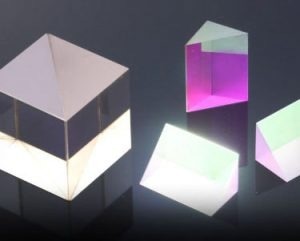Beamsplitters can be used in a wide range of fields, such as optics and interferometry. These important devices come in different forms and have many different applications, but many people are unsure of the key principles of their use.
This article explores the core functionality of beamsplitters, delving into their different types and their many applications.
Principles of Beamsplitters
Beamsplitters are optical devices able to either split an incident light beam into two separate beams or combine two incoming beams from distinct angles into a single output. These versatile tools can split both laser and regular light, depending on the application in question.

Image Credit: Shanghai Optics
Types of Beamsplitters
A number of different beamsplitter types exist, including plate beamsplitters, cube beamsplitters, and polka-dot beamsplitters. Each type offers specific features and advantages, depending on their desired use.
Plate Beamsplitters
The majority of plate beamsplitters are manufactured using dielectric materials. These beamsplitters are generally employed at 45° of incidence, but they can be configured to accommodate a wide range of incidence ratios.
These devices are less prone to outputting chromatic aberrations, making them superior to other types of beamsplitter in that respect.
Plate beamsplitters are more affordable than other options (for example, cube beamsplitters), making them an ideal choice for budding optical engineers. Their construction is also simpler; they weigh less and may be produced in large quantities relatively easily.
Plate beamsplitters do not require optical cement to hold the two halves of the prism together. This is an advantageous feature because lasers can rapidly damage cement, and it is prone to breaking down with ongoing exposure to UV light.
These beamsplitters are also thinner than their cube counterparts, requiring less material for light to effectively pass through them.
Cube Beamsplitters
Cube beamsplitters are produced by coating the hypotenuse of dual prisms with a partially reflective material prior to joining these together using optical or epoxy cement.
These beamsplitters are able to effectively eliminate ghosting, because the transmitted beam remains coherent with the incident light beam. A cube beam splitter’s ability to eliminate ghost images affords it a noteworthy advantage over a plate beamsplitter.
Cube beamsplitters can accommodate a shorter optical path length than plate beamsplitters. They are also able to maintain equal path lengths, smoothly integrating these into an optical system by maintaining a 0° angle of incidence.
Polka-Dot Beamsplitters
These beamsplitters feature a specific polka-dot-like surface, with half of the surface comprised of dots created using photolithography or mechanical masking (with any required ratio). This characteristic provides polka-dot beamsplitters with an almost continuous R/T ratio that remains independent of the viewing angle.
Beamsplitter Functionality
Beamsplitters are capable of dividing the incoming light into several streams. A number of factors impacts this splitting process; for example, the wavelength, intensity, or polarity, or the incoming light; or the construction and settings of the beamsplitter itself.
Beamsplitters may vary in terms of their size, shape, and material, but all work on the principle that the splitter transmits one part of the beam while reflecting the other.
To direct reflected light towards a desired direction instead of back to its source, the splitter or reflecting surface should be angled correctly relative to the incoming light.
Common Applications of Beamsplitters
Beamsplitters’ ability to separate or combine two sources of light with precise R/T ratios makes them ideally suited to a number of technological applications, including sensors, lasers, semiconductors, and cameras.
A number of other common beamsplitter applications are outlined below.
Heads-Up Displays (HUDs)
Beamsplitters are commonly employed in heads-up displays - transparent surfaces with images projected onto them. For example, some heads-up displays utilize a combination of a beamsplitter, projection, and lens systems to project an image onto a moving vehicle’s exterior via laser light.
Interferometry
Interferometry, a key application of this technology, involves splitting a beam of light reflected from a surface into two parts. The resulting interference patterns, created when the split beams recombine with the reflected light, are used to measure distances accurately.
Lasers
Beamsplitters are commonly employed in lasers to create different beam paths, achieving this effect by dividing the laser beam into multiple segments and then recombining them. This allows the direction and intensity of the beam to be adjusted with outstanding precision and versatility.
Optical Equipment
Beamsplitters are used in a diverse array of optical equipment. Optical beamsplitters allow the beam of light to be divided into multiple segments, which can be individually diverted using other inputs. This powerful tool affords users a range of options for directing and shaping the light beam.
Conclusion
A beamsplitter is a device designed to either divide or combine light, depending on its intended use. It operates by splitting incoming light into one or two beams, with one or more beams passing through the optical element and one or more beams being redirected at an angle away from it. This tool is crucial for various applications, including lasers, heads-up displays, and other devices.
Acknowledgments
Produced from materials originally authored by Shanghai Optics Inc.

This information has been sourced, reviewed and adapted from materials provided by Shanghai Optics.
For more information on this source, please visit Shanghai Optics.